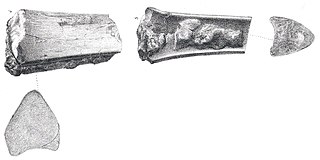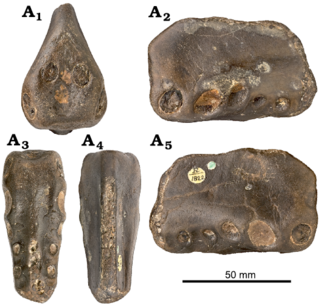
The Romualdo Formation is a geologic Konservat-Lagerstätte in northeastern Brazil's Araripe Basin where the states of Pernambuco, Piauí and Ceará come together. The geological formation, previously designated as the Romualdo Member of the Santana Formation, named after the village of Santana do Cariri, lies at the base of the Araripe Plateau. It was discovered by Johann Baptist von Spix in 1819. The strata were deposited during the Aptian stage of the Early Cretaceous in a lacustrine rift basin with shallow marine incursions of the proto-Atlantic. At that time, the South Atlantic was opening up in a long narrow shallow sea.

The Oxford Clay is a Jurassic marine sedimentary rock formation underlying much of southeast England, from as far west as Dorset and as far north as Yorkshire. The Oxford Clay Formation dates to the Jurassic, specifically, the Callovian and Oxfordian ages, and comprises two main facies. The lower facies comprises the Peterborough Member, a fossiliferous organic-rich mudstone. This facies and its rocks are commonly known as lower Oxford Clay. The upper facies comprises the middle Oxford Clay, the Stewartby Member, and the upper Oxford Clay, the Weymouth Member. The upper facies is a fossil poor assemblage of calcareous mudstones.

Ornithocheirus is a pterosaur genus known from fragmentary fossil remains uncovered from sediments in the United Kingdom and possibly Morocco.

Eucercosaurus is the name given to a genus of ornithopod dinosaur from the Albian stage of the Early Cretaceous. It was an ornithopod discovered in the Cambridge Greensand of England and is known from 19 centra, 3 sacrals, 4 dorsals and 12 caudals, and a neural arch found near Trumpington, Cambridgeshire. The type species, E. tanyspondylus, was described by British paleontologist Harry Seeley in 1879.

Tropeognathus is a genus of large pterosaurs from the late Early Cretaceous of South America. This genus is considered to be a member of the family Anhangueridae, however, several studies have also recovered it within another family called Ornithocheiridae. Both of these families are diverse groups of pterosaurs known for their keel-tipped snouts and large size. Tropeognathus is regarded as the largest pterosaur found in the Southern Hemisphere, only rivaled by the huge azhdarchids. The type and only species is Tropeognathus mesembrinus. Fossil remains of Tropeognathus have been recovered from the Romualdo Formation, which is a Lagerstätte located in the Santana Group of the Araripe Basin in northeastern Brazil.

Ornithostoma is a genus of pterodactyloid pterosaur that lived during the Early Cretaceous period of Europe, around 110 million years ago. Ornithostoma was once thought to have been a senior synonym of the pteranodontid Pteranodon due to its toothless anatomy and prior naming.

Coloborhynchus is a genus of pterodactyloid pterosaur belonging to the family Anhangueridae, though it has also been recovered as a member of the Ornithocheiridae in some studies. Coloborhynchus is known from the Lower Cretaceous of England, and depending on which species are included, possibly the Albian and Cenomanian ages as well. Coloborhynchus was once thought to be the largest known toothed pterosaur, however, a specimen of the closely related Tropeognathus is now thought to have had a larger wingspan.

Lonchodectes was a genus of lonchodectid pterosaur from several formations dating to the Turonian of England, mostly in the area around Kent. The species belonging to it had been assigned to Ornithocheirus until David Unwin's work of the 1990s and 2000s. Several potential species are known; most are based on scrappy remains, and have gone through several other generic assignments. The genus is part of the complex taxonomy issues surrounding Early Cretaceous pterosaurs from Brazil and England, such as Amblydectes, Anhanguera, Coloborhynchus, and Ornithocheirus.

Lonchodectidae or Lonchodraconidae is a group of pterosaurs within the clade Pterodactyloidea. It has variously been considered to be within Ctenochasmatoidea, Azhdarchoidea and Pteranodontia. They are notable for their high, conical tooth sockets and raised alveolar margins.

Ornithocheiridae is a group of pterosaurs within the suborder Pterodactyloidea. These pterosaurs were among the last to possess teeth. Members that belong to this group lived from the Early to Late Cretaceous periods, around 140 to 90 million years ago.

The Wessex Formation is a fossil-rich English geological formation that dates from the Berriasian to Barremian stages of the Early Cretaceous. It forms part of the Wealden Group and underlies the younger Vectis Formation and overlies the Durlston Formation. The dominant lithology of this unit is mudstone with some interbedded sandstones. It is part of the strata of the Wessex Basin, exposed in both the Isle of Purbeck and the Isle of Wight. While the Purbeck sections are largely barren of vertebrate remains, the Isle of Wight sections are well known for producing the richest and most diverse fauna in Early Cretaceous Europe.
The Mackunda Formation is a geological formation in Queensland, Australia whose strata date back to the Early Cretaceous. Dinosaur remains are among the fossils that have been recovered from the formation. It consists primarily of interbedded and cross bedded greensand, with variably calcareous shale, with local ferricrete.

The Kem Kem Group is a geological group in the Kem Kem region of eastern Morocco, whose strata date back to the Cenomanian stage of the Late Cretaceous. Its strata are subdivided into two geological formations, with the lower Ifezouane Formation and the upper Aoufous Formation, with the Gara Sbaa Formation and Douira Formation used in the southern Tafilalt region. It is exposed on an escarpment along the Algeria–Morocco border.

Pteranodontoidea is an extinct clade of ornithocheiroid pterosaurs from the Early to Late Cretaceous of Asia, Africa, Europe, North America and South America. It was named by Alexander Wilhelm Armin Kellner in 1996. In 2003, Kellner defined the clade as a node-based taxon consisting of the last common ancestor of Anhanguera, Pteranodon and all its descendants. The clade Ornithocheiroidea is sometimes considered to be the senior synonym of Pteranodontoidea, however it depends on its definition. Brian Andres in his analyses, converts Ornithocheiroidea using the definition of Kellner (2003) to avoid this synonymy.

Lonchodraco is a genus of lonchodraconid pterodactyloid pterosaur from the Late Cretaceous of southern England. The genus includes species that were previously assigned to other genera.

Camposipterus is a genus of pterodactyloid pterosaur from the Early Cretaceous of England. Fossil remains of Camposipterus dated back to the Early Cretaceous, about 112 million years ago.

This timeline of pterosaur research is a chronologically ordered list of important fossil discoveries, controversies of interpretation, and taxonomic revisions of pterosaurs, the famed flying reptiles of the Mesozoic era. Although pterosaurs went extinct millions of years before humans evolved, humans have coexisted with pterosaur fossils for millennia. Before the development of paleontology as a formal science, these remains would have been interpreted through a mythological lens. Myths about thunderbirds told by the Native Americans of the modern Western United States may have been influenced by observations of Pteranodon fossils. These thunderbirds were said to have warred with water monsters, which agrees well with the co-occurrence of Pteranodon and the ancient marine reptiles of the seaway over which it flew.

Ornithocheiromorpha is a group of pterosaurs within the suborder Pterodactyloidea. Fossil remains of this group date back from the Early to Late Cretaceous periods, around 140 to 92.5 million years ago. Ornithocheiromorphs were discovered worldwide except Antarctica, though most genera were recovered in Europe, Asia and South America. They were the most diverse and successful pterosaurs during the Early Cretaceous, but throughout the Late Cretaceous they were replaced by better adapted and more advanced pterosaur species such the pteranodontids and azhdarchoids. The Ornithocheiromorpha was defined in 2014 by Andres and colleagues, and they made Ornithocheiromorpha the most inclusive clade containing Ornithocheirus, but not Pteranodon.

Nicorhynchus is a genus of anhanguerid pterosaur from the Cretaceous period. It contains two species, the type species, N. capito, from the Cambridge Greensand of England, and N. fluviferox from the Kem Kem Group of Morocco. These species were previously assigned to Coloborhynchus.















